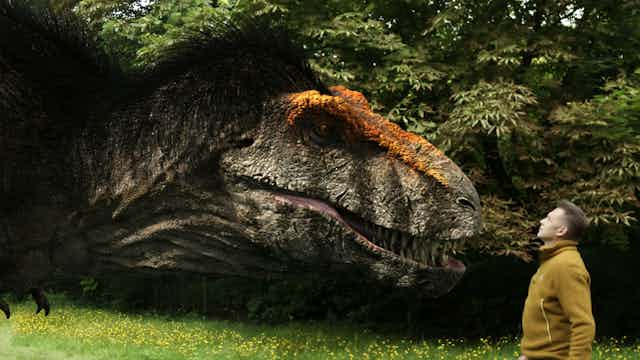The chance to work on a major documentary is always a testing experience for a researcher. It’s a huge opportunity to communicate cutting edge research to the public, but the way the information is presented can lack nuance and detail. This is especially true for dinosaur documentaries that are inevitably watched by young children and have to counter a huge range of myths that have built up in the popular imagination. Trying to educate, inform and entertain the audience all at once is a huge challenge.
Yet when I was invited to become a consultant for The real T. rex with Chris Packham, I knew it was an opportunity not to be missed. Tyrannosaurus rex is not only the king of the dinosaurs but arguably the most famous animal we only know from fossils. A TV show on this species is an excellent opportunity for outreach and to try to steer conversations away from things like the endlessly recycled, and long ago settled, question of whether T. rex was a predator or a scavenger (the answer to this is incidentally, both).
Here I must briefly mention Jurassic Park, even though I’d love not to. When the original film came out in 1993 it did more for getting across then current scientific thinking on dinosaurs than almost anything else ever could. Gone was the image of tail-dragging, upright, lumbering, swamp-dwellers and in came fast, active, and perhaps even intelligent, animals.
This dragged the public image of dinosaurs out of the 1960s and into the 1990s. Unfortunately, another 25 years later the science has moved on again but people’s impressions have not. The challenge is not just to introduce new ideas but overturn old ones.
Latest research
In the case of T. rex , we have learned a huge amount in the last 25 years and it has even become something of a model organism for dinosaur researchers. We have new data on their movement, feeding habits, brain and inner ears and more.
Many of these ideas come from studying incomplete and fragmentary fossils. And however solid the research, this is never going to make exciting viewing. So ideas need to be new, easy to communicate, and contain certain level of whizz-bang for the audience. Access to specimens, and even researchers, for filming can limit the options further.
One excellent example of this was the programme’s section on the tyrannosaur’s bite, with an on-screen comparison with a live alligator. This gave us an opportunity to show off the gator’s bite, which was fun for the audience. But it also meant we could explain or reference the unusual shape of tyrannosaur teeth, the size and shape of their heads, the attachment sites for the jaw muscles, and the evolutionary relationship between crocodilians and dinosaurs.
Bringing fossils to life
We also filmed (although it was sadly cut for time from the final show) was a Triceratops pelvis showing bite marks from a Tyrannosaurus. This allowed us to actually include trace fossils as well. So a single short section covered multiple areas of comparative anatomy, experimental palaeontology, evolution, and ichnology (the study of animal traces like footprints). These were all integrated to build up a single coherent picture of tyrannosaur behaviour, backed by multiple research papers and presented with a bit of flair and easy frame of reference (namely a big alligator).
In contrast, we had real problems getting the animal’s appearance right because the speed of research outstripped the production. We know several types of tyrannosaur had feathers and researchers have reasonably assumed that T. rex did too. But during production a new paper came out describing some fossilised T. rex skin that showed scales. Although the paper’s authors explicitly didn’t rule out feathers on T. rex, the research obviously meant that we needed to change our initial approach of a near fully feathered dinosaur, to one with a sparser coat.
Documentaries are a great way to potentially reach a huge audience and really engage with the public. The filter of writers, directors, producers and presenters means key messages can go awry, and there will always be compromises and concessions to the practicalities of filming. But the rewards are massive. Just didn’t expect anyone but your family to notice your name in the credits.

